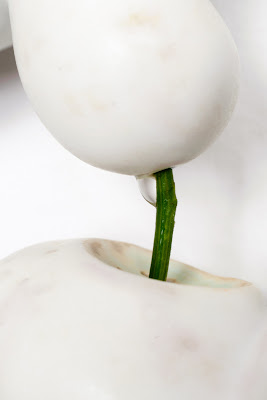I arrived on Thursday and began the day in the session, The Art of Pranks, with chair Beauvais Lyons, University of Tennessee. Lyons began the session flipping through slides of pranks by artists, including Marcel Duchamp, Damien Hirst, and Jeff Koons. Humor is at the core of Prank, particularly how it is used to engage with political discourse. With such an engaging topic, I was glad many of the papers took a more lighthearted approach in presentation format. For example, self-proclaimed “artivist,” Clark Stoeckley, presented his talk in the guise of “Officer Stoeckley of the NYPD.” Stoeckley provided an overview of pranks by graffiti and performance artists that were both playful and illustrative of political resistance. This made me curious about which craft artists have engaged with prank theory through their work. Surely, Wendell Castle’s 1978 piece, Coat Rack with Trench Coat, in the collection of the Museum of Fine Arts, Houston, would be considered prankster? (Although, made of wood, it mimics a coat in the style of trompe l’oeil.) Another example of prankish craft is the recent exhibit from the Wood Turning Center, Challenge VII: DysFUNctional, which features objects that subvert function and are made with the kind of humor and whimsy frequently found at the core of Prank.
Following this session, I attended Narcissism, a topic organized by the Queer Caucus for Art: The Lesbian, Gay, Bisexual and Transgender Caucus for Art, Artists, and Historians. With a strong schedule of presenters, I would need to devote multiple posts to each presentation. I thought the strongest presentations were It’s all about ME, Not You: The Art of Greer Lankton, by Jonathan Weinberg, independent artist and scholar, and Shame-Flushed Flaming: Narcissism and the Queer Potentials of Photography, presented by Jill Casid, University of Wisconsin, Madison. Overall, I am most interested in applying queer theory and the topics discussed to practices surrounding craft. Fiber artists, Lacey Jane Roberts, Josh Faught and Aaron McIntosh are just a few artists that come to mind who are dealing with issues surrounding queer identity and hetero-norms of society and craft.
Looking ahead, Friday promised another full day of sessions, with many surrounding craft specifically. In the morning, Betty Crouther, University of Mississippi, and Crystal Hui-Shu Yang, University of North Dakota, chaired and presented papers in Cultural Diversity and Human Creativity: The Continuation of Traditional Craftsmanship. Presenter Joshua Almond, of Rollins College, discussed the simplistic approach of the art-versus-craft debate in his presentation, Liberal Arts Colleges as Stewards of Traditional Craftsmanship. He referenced Glenn Adamson’s new book, Thinking through Craft, and his discussion of craft as a process. Almond explained how the interdisciplinary model of liberal arts schools is similar to the model with which we should discuss craft—a dialogue that is not solely about material exploration. Following this talk was the much anticipated session, Where Is Tradition in American Studio Craft?, chaired by Katie Lee, Assistant Director of the Center for Craft, Creativity and Design. The three presentations in this session were topical and gave constructive criticism to the notions behind the loaded word, tradition. Audio recordings and PDF documents of this session can be found on the Center for Craft, Creativity and Design’s website.
According to the Merriam-Webster Dictionary, tradition is cultural continuity in social attitudes, customs and institutions. When examining the relationship of craft to society, the presenters agreed that, while craft references traditions of the past, it is a nimble and responsive medium that engages with current society on a variety of levels.
Philadelphia Museum of Art, and Tom Loeser, Professor at the University of Wisconsin, Madison, highly engaging and relevant. Agro articulated the need to shift the rhetoric of tradition to that of heritage. She used the material history of porcelain and cleverly highlighted how objects created today reference those from the past. Contemporary works are not made in a traditional style, but instead honor certain stylistic or material references from the past, the heritage of the material. Loeser presented artists and works that re-contextualize traditions of the past, placing craft into a successful relationship with art and design. One such example was Safely Maneuvering Across Lin He Road, a performance piece by Chinese artist, Lin Yillin, in which he continually rebuilds a concrete wall, while crossing a pedestrian crosswalk during traffic. Loeser mentions how this work displays the radical act of a mundane action, the traditions of wall building and even labor practices. Following this panel, Namita Gupta Wiggers, Curator at the Museum of Contemporary Craft, was the discussant and led the beginnings of what could have been a provocative discussion had our session time not lapsed.
Lin Yillin (Chinese, b. 1964) Safely Maneuvering Across Lin He Road. 1995.
Single channel video, sound, 36 minutes, 45 seconds.
Asia Society, New York: Promised Gift of Harold and Ruth Newman.
Single channel video, sound, 36 minutes, 45 seconds.
Asia Society, New York: Promised Gift of Harold and Ruth Newman.
Anna Walker
Curatorial Fellow
Houston Center for Contemporary Craft
Anna Walker continues with her report, reviewing the final day of presentations and her conclusions from the conference in Part II.








